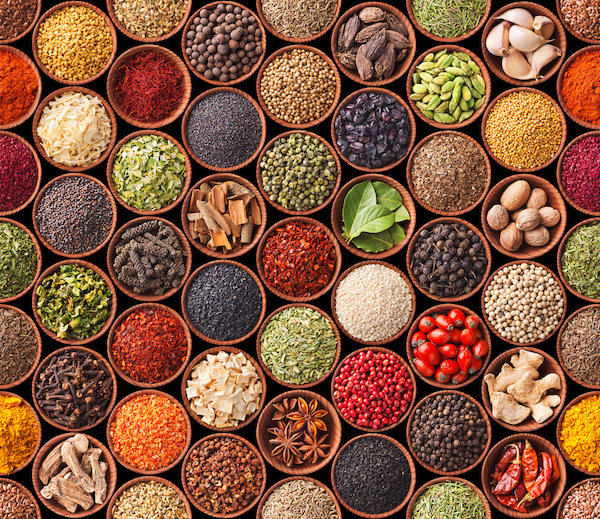6 Healthy Herbs and Spices and How to Use Them
Fruits, vegetables, grain dishes, legumes, and meats are commonly consumed around the world. But if you’ve ever tried collard greens from Brazil and then from the south of the United States, you know that they taste very different.
What’s the main difference between these two foods?
The secret to the difference in taste isn’t in the food itself but rather in how it is prepared and seasoned.
Needless to say, herbs and spices are seemingly magical ingredients that transform a bland dish into an explosion of tastes in your mouth.
Herbs and spices are a wonderful way to make just about any food ignite the senses. Herbs and spices also add countless healthy phytochemicals, including antioxidants, to any meal.
Phytochemicals are plant-based chemicals that are biologically active and interact with the human body to produce health-promoting outcomes.
You may have heard of certain herbs and spices that help to support your health, but you are unsure what foods they are found in or, if you like to get creative, how to use them in the kitchen.
This article describes the health properties of six herbs and spices and then lists several dishes where they are commonly found. For those who like experimenting in the kitchen, we also suggest several types of dishes that go well with each of them.
Turmeric
Turmeric is known as “the Golden Spice,” thanks to its bright yellow-orange color. In addition to being a central spice in numerous Asian dishes, turmeric has been used as a medicine in Ayurveda for at least 4000 years, thanks to its pharmacological and biological activity. Today, turmeric continues to be used as an herbal medicine for rheumatoid arthritis, chronic anterior uveitis, conjunctivitis, skin cancer, smallpox, chicken pox, wound healing, urinary tract infections, liver ailments, digestive disorders, abdominal pain, colic, and several other conditions.
Needless to say, turmeric is very high in phenolic compound activity. Curcuminoids are found to be natural antioxidants. Other natural compounds in turmeric that support health are curcumin and volatile oil, which, together, have been found to have antibacterial, antiviral, anti-inflammatory, antitumor, antioxidant, antiseptic, cardioprotective, hepatoprotective, nephroprotective, radioprotective, and digestive activities.
Global Dishes that Use Turmeric
Many dishes that have turmeric originated in Southeast Asia. These include:
- Masala Dosa from India
- Onion Bhaji from India
- Pastilla from Morocco
- Samosa from India
- Tajine Maadnous from Tunisia
- Tohu Thoke from Burma
- Amba from Iraq and the Middle East
Some Ways to Integrate Turmeric into Your Dishes Include:
- In smoothies with ginger and the fruit of your choice
- In curries and chilis
- To season meats and vegetables
- As a flavor-booster in soups
Note that curry powder contains turmeric, so if the taste of pure turmeric is too bitter for you, try using curry powder instead.
Ginger
Ginger is an aromatic root that has been used as a tonic root In India and China for over 5000 years. It was desired by the Roman Empire over 2000 years ago due to its medicinal properties, which made it an important article of trade in those times.
Researchers have identified several bioactive compounds in ginger, including several forms of gingerol, paradol, shogaol, and gingernone, among others. Together, these components have been credited with ginger’s antioxidant, anti-inflammatory agent, anti-nausea compound, and anticancer agent, as well as the protective effect of ginger against other disease conditions. To this day, ginger is used for the treatment of numerous ailments, such as colds, nausea, arthritis, migraines, and hypertension.
Global Dishes that Use Ginger
- Ginger chicken from Indonesia
- Ginger juice from West Africa
- Ginger chicken from China
- Pickled ginger from Japan
- Jujube ginger tea from Korea
- Braised belfish from Korea
- Gingerbread cookies from England
Some Ways to Integrate Ginger into Your Dishes Include:
- Boiled in water to make ginger tea
- In sauces, glazes, and marinades
- In homemade versions of noodle bowls and stir fry
- In warm and cold soups
Lemongrass
Lemongrass is an herb that looks very much like long grass or reeds and originates from tropical climates. It thrives in heat and, if you choose to grow some at home, should be moved indoors or into a greenhouse when the weather gets colder. While it has many beneficial compounds, it is best known for controlling pathogens and for increasing herbal resistance to pathogenic diseases.
While it is commonly prepared as a tea or tonic for medicinal purposes, its rich aroma makes it a popular ingredient in nonalcoholic beverages, baked foods, and baked goods.
Lemongrass is high in citral monoterpenes and myrcene, both of which have antibacterial, antifungal, anti-inflammatory, hypolipidemic, anticarcinogenic, and antioxidant properties.
Global Dishes that Use Lemongrass
Some global dishes that contain lemongrass include:
- Beef rendang from Indonesia
- Tom yum soup from Thailand
- Curry paste from Southeast Asia
- Ginger and lemongrass iced tea from Sierra Leone
- Coconut shrimp soup from Cambodia
Some Ways to Integrate Lemongrass into Your Dishes Include:
- Salad dressings
- Marinades
- Boiled to make tea
- Curries
- Soups
- Stews
Cinnamon
Cinnamon might be a staple spice for you; it is one of the most commonly used spices in sweets around the world. It is aromatic and is often described as warm, sweet, and spicy. Cinnamon comes from the inner part of the bark of the cinnamon tree. It is native to Sri Lanka, and it was once more valuable than gold.
Researchers have found that the species of cinnamon differ slightly in their flavonoid content and antioxidant capacity.
Some of the most beneficial phenolic compounds of cinnamon include cinnamic acid, sinapic acid, p-coumaric acid, vanillin, and caffeic acid. Cinnamon and its components have high anti-inflammatory, antitumor, and anti-Alzheimer activity. It also helps the body regulate blood glucose spikes, which has led researchers to identify cinnamon as an anti-diabetic spice.
Global Dishes that Use Cinnamon
- Mole from Mexico
- Atole from Guatemala
- Khichdi from South Asia
- Pastitsio from Greece
- Cincinnati chili from Ohio
- Harira from Morocco
- Kai palo from Thailand
- Kanelglas from Sweden
Some Ways to Integrate Cinnamon into Your Dishes Include:
- Oatmeal or over cereal
- Smoothies
- Teas and coffee
- Chilis and fall and winter soups
- Baked goods
Cayenne Pepper
Cayenne pepper is native to North and South America, and archeologists found evidence of its use as far back as 8000 years ago. It was likely used to spice up Indigenous diets based on tubers, maize, and beans, but there is evidence of its medicinal and ritualistic uses as well. Mayans, for example, used peppers, like cayenne, to treat asthma, coughs, and sore throats, and Aztecs took advantage of the anesthetic effect of chilis to relieve toothaches.
It has a high antioxidant capacity and overall phenolic compound content. It is also high in flavanols, proanthocyanins, and polyphenols, the combination of which gives way to cayenne pepper’s ability to help defend cells against antioxidative damage and inflammation.
Global Dishes that Use Cayenne Pepper
- Enchiladas from Mexico
- Hot chocolate from Mexico
- Various curries from India
- Chili crab from Singapore
- Hot chili oil from China
- Koshari from Egypt
Some Ways to Integrate Cayenne into Your Dishes Include:
- Vegetable and meat marinades
- Spicy sauces
- Hot dips
- Bean mixtures
- Added to breadcrumb or panko mixtures for breaded dishes
- Vegetable soups
Peppermint
Peppermint has been in use for at least 3000 years , primarily as a remedy for indigestion. It was first cultivated, however, in England in the late 17th century. Today, peppermint is one of the most widely consumed herbal teas to help promote digestion and relieve gastrointestinal discomfort or simply for the taste.
In the essential oil form, it has been long used as a traditional medicine. Some of the phenolic constituents and volatile components of peppermint leaves include rosmarinic acid, eriocitrin, luteolin, and hesperin menthol and methone. Researchers have found that peppermint has important antimicrobial and antiviral activities, in addition to strong antioxidant, antitumor and antiallergenic properties.
Global Dishes that Use Peppermint
- Pho with mint, from Vietnam
- Chicken stir-fry from Thailand
- Pesto from Italy
- Quinoa salad from the Middle East
- Mint Chutney from India
- Roast lamb with mint jelly from the UK
- Red snapper in red pepper mint sauce from Egypt
- Peppermint candy from Europe
Some Ways to Integrate Peppermint into Your Dishes Include:
- Spooned into yogurt
- Baked goods
- Tea made with fresh or dried leaves
- As a topping for dessert
- With fruit, especially blueberries, mangoes, and watermelon
- As an addition to lemonade or lemon water
- In pesto sauce
- To make peppermint ice cream
- In salad dressings
Main Takeaways
There are nearly endless herbs and spices that humans have been using as medicine and in cuisine simultaneously for thousands of years. Herbs and spices add flavor to sweet and savory foods while also contributing powerful polyphenols, flavonoids, and antioxidant compounds to our dishes.
Regardless of the intrigue the health properties of these herbs and spices cause, they are rarely enjoyable when consumed alone unless they are prepared as tea. They do, however, add wonderful flavors to the foods we eat.
In this article, we highlighted six herbs and spices with powerful health properties and several ideas on how to integrate them into your regular meals.
We encourage you to use this list as only a starting point. The list of health-promoting herbs and spices is nearly endless, and the more you get accustomed to integrating them into your daily meals, the better!
References:
- https://www.ncbi.nlm.nih.gov/books/NBK92752/
- https://pubmed.ncbi.nlm.nih.gov/15673996/
- https://www.ncbi.nlm.nih.gov/books/NBK92775/
- https://www.sciencedirect.com/science/article/abs/pii/S030881460600481X
- https://lpi.oregonstate.edu/mic/dietary-factors/phytochemicals
- https://www.sciencedirect.com/science/article/abs/pii/S1466856409000605
- https://www.tandfonline.com/doi/full/10.1080/10942912.2017.1369102
- https://herbsocietyblog.wordpress.com/2021/08/02/cayenne-pepper-herb-of-the-month/
- https://www.ajol.info/index.php/ijbcs/article/view/85278
- https://www.researchgate.net/profile/Gloria-Otunola/publication/278077687_Evaluation_of_the_polyphenolic_contents_and_some_antioxidant_properties_of_aqueous_extracts_of_Garlic_Ginger_Cayenne_Pepper_and_their_mixture/links/5e674d75a6fdcc37dd15e6b9/Evaluation-of-the-polyphenolic-contents-and-some-antioxidant-properties-of-aqueous-extracts-of-Garlic-Ginger-Cayenne-Pepper-and-their-mixture.pdf
- https://pubmed.ncbi.nlm.nih.gov/16767798/
Disclaimer: all images are owned and copyright by their respective owners and website (www.afpafitness.com) and “https://madcity.fitness/blog” is for news, information, product news and reviews.









